A Summary of 1:1 Nurse Patient Ratio: Rapid Review of Reviews
VerifiedAdded on 2023/03/20
|46
|9783
|84
Report
AI Summary
This report presents a rapid review of systematic reviews examining the effectiveness of a 1:1 nurse-to-patient ratio. The background highlights the importance of adequate nurse staffing in improving patient safety, reducing medication errors, hospital-acquired infections, and decreasing nurse workload and stress. The objective is to analyze the impact of 1:1 ratios on patient outcomes. Inclusion criteria focused on systematic reviews published within the last ten years. The review included registered and enrolled nurses as participants, assessing the impact of 1:1 ratios on patient safety and quality of care. The search strategy utilized PubMed and CINHAL databases. Methodological quality was assessed using the AMSTAR tool. Results indicated that increased nurse staffing improved patient safety, nurse satisfaction, and reduced turnover. The conclusion underscores the importance of 1:1 nurse-to-patient ratios for enhancing overall patient care outcomes. The report includes detailed methodology, results, and discussion of the findings, along with appendices providing search strategies, PRISMA diagrams, and quality assessments.
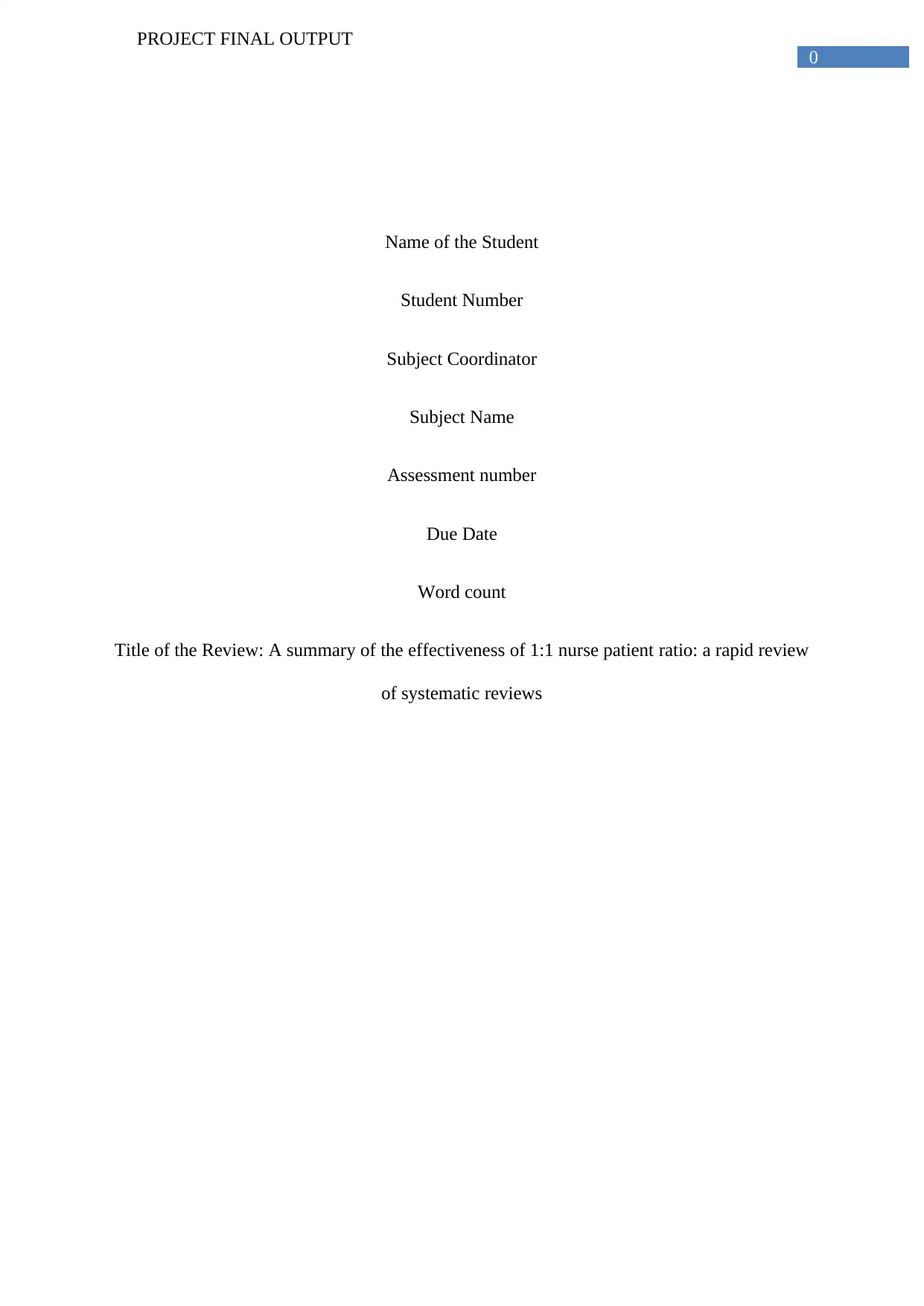
0
PROJECT FINAL OUTPUT
Name of the Student
Student Number
Subject Coordinator
Subject Name
Assessment number
Due Date
Word count
Title of the Review: A summary of the effectiveness of 1:1 nurse patient ratio: a rapid review
of systematic reviews
PROJECT FINAL OUTPUT
Name of the Student
Student Number
Subject Coordinator
Subject Name
Assessment number
Due Date
Word count
Title of the Review: A summary of the effectiveness of 1:1 nurse patient ratio: a rapid review
of systematic reviews
Paraphrase This Document
Need a fresh take? Get an instant paraphrase of this document with our AI Paraphraser
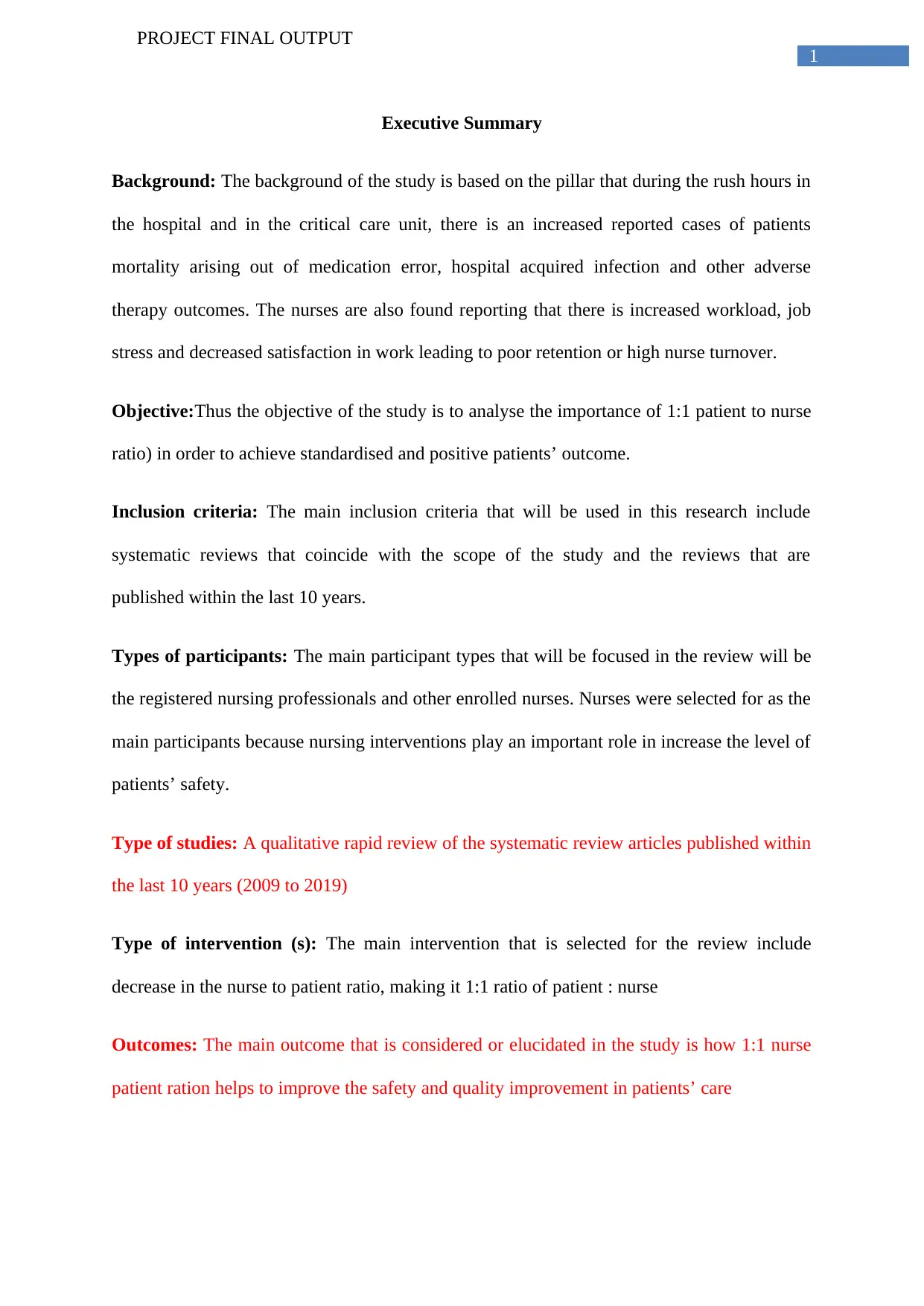
1
PROJECT FINAL OUTPUT
Executive Summary
Background: The background of the study is based on the pillar that during the rush hours in
the hospital and in the critical care unit, there is an increased reported cases of patients
mortality arising out of medication error, hospital acquired infection and other adverse
therapy outcomes. The nurses are also found reporting that there is increased workload, job
stress and decreased satisfaction in work leading to poor retention or high nurse turnover.
Objective:Thus the objective of the study is to analyse the importance of 1:1 patient to nurse
ratio) in order to achieve standardised and positive patients’ outcome.
Inclusion criteria: The main inclusion criteria that will be used in this research include
systematic reviews that coincide with the scope of the study and the reviews that are
published within the last 10 years.
Types of participants: The main participant types that will be focused in the review will be
the registered nursing professionals and other enrolled nurses. Nurses were selected for as the
main participants because nursing interventions play an important role in increase the level of
patients’ safety.
Type of studies: A qualitative rapid review of the systematic review articles published within
the last 10 years (2009 to 2019)
Type of intervention (s): The main intervention that is selected for the review include
decrease in the nurse to patient ratio, making it 1:1 ratio of patient : nurse
Outcomes: The main outcome that is considered or elucidated in the study is how 1:1 nurse
patient ration helps to improve the safety and quality improvement in patients’ care
PROJECT FINAL OUTPUT
Executive Summary
Background: The background of the study is based on the pillar that during the rush hours in
the hospital and in the critical care unit, there is an increased reported cases of patients
mortality arising out of medication error, hospital acquired infection and other adverse
therapy outcomes. The nurses are also found reporting that there is increased workload, job
stress and decreased satisfaction in work leading to poor retention or high nurse turnover.
Objective:Thus the objective of the study is to analyse the importance of 1:1 patient to nurse
ratio) in order to achieve standardised and positive patients’ outcome.
Inclusion criteria: The main inclusion criteria that will be used in this research include
systematic reviews that coincide with the scope of the study and the reviews that are
published within the last 10 years.
Types of participants: The main participant types that will be focused in the review will be
the registered nursing professionals and other enrolled nurses. Nurses were selected for as the
main participants because nursing interventions play an important role in increase the level of
patients’ safety.
Type of studies: A qualitative rapid review of the systematic review articles published within
the last 10 years (2009 to 2019)
Type of intervention (s): The main intervention that is selected for the review include
decrease in the nurse to patient ratio, making it 1:1 ratio of patient : nurse
Outcomes: The main outcome that is considered or elucidated in the study is how 1:1 nurse
patient ration helps to improve the safety and quality improvement in patients’ care
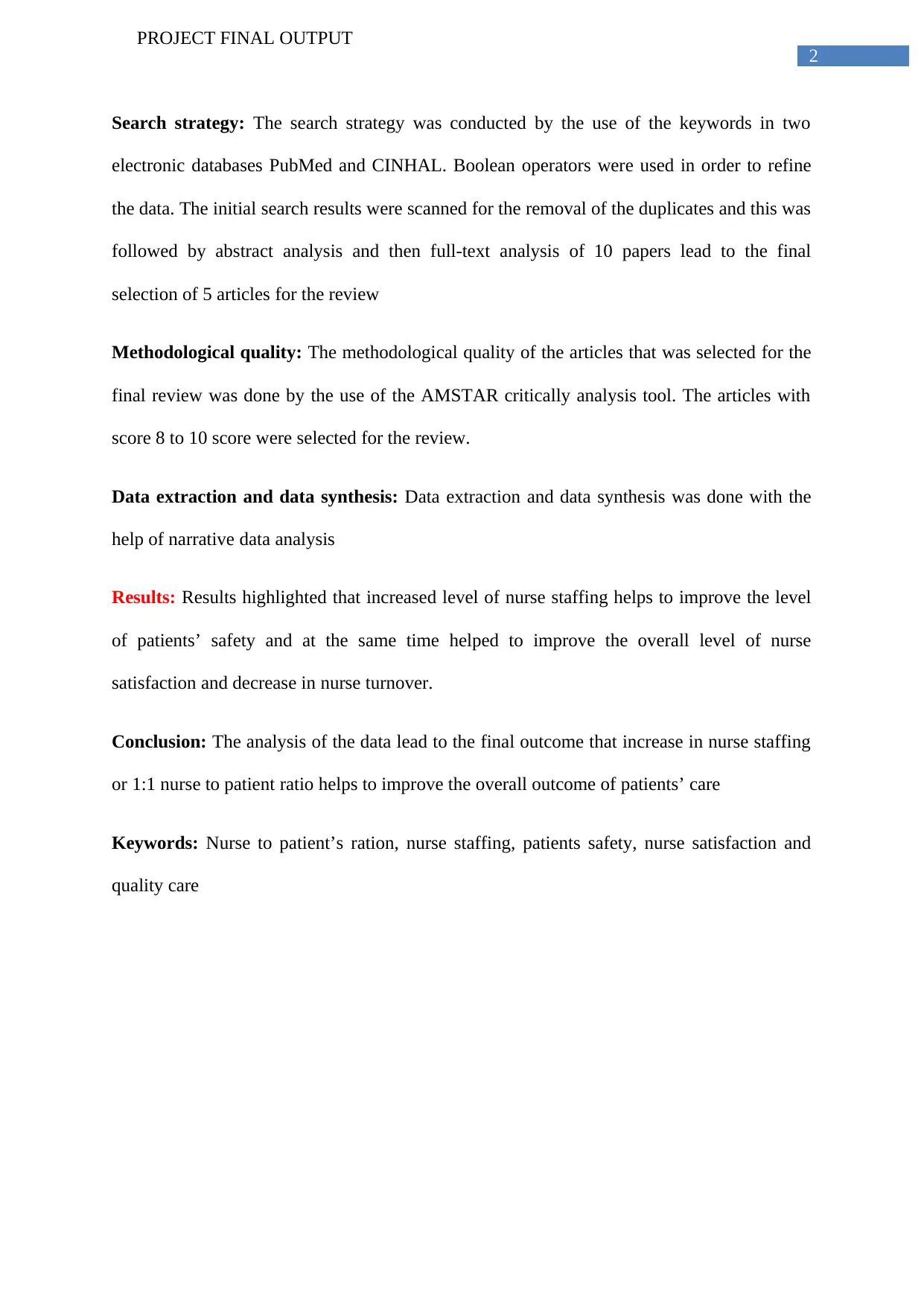
2
PROJECT FINAL OUTPUT
Search strategy: The search strategy was conducted by the use of the keywords in two
electronic databases PubMed and CINHAL. Boolean operators were used in order to refine
the data. The initial search results were scanned for the removal of the duplicates and this was
followed by abstract analysis and then full-text analysis of 10 papers lead to the final
selection of 5 articles for the review
Methodological quality: The methodological quality of the articles that was selected for the
final review was done by the use of the AMSTAR critically analysis tool. The articles with
score 8 to 10 score were selected for the review.
Data extraction and data synthesis: Data extraction and data synthesis was done with the
help of narrative data analysis
Results: Results highlighted that increased level of nurse staffing helps to improve the level
of patients’ safety and at the same time helped to improve the overall level of nurse
satisfaction and decrease in nurse turnover.
Conclusion: The analysis of the data lead to the final outcome that increase in nurse staffing
or 1:1 nurse to patient ratio helps to improve the overall outcome of patients’ care
Keywords: Nurse to patient’s ration, nurse staffing, patients safety, nurse satisfaction and
quality care
PROJECT FINAL OUTPUT
Search strategy: The search strategy was conducted by the use of the keywords in two
electronic databases PubMed and CINHAL. Boolean operators were used in order to refine
the data. The initial search results were scanned for the removal of the duplicates and this was
followed by abstract analysis and then full-text analysis of 10 papers lead to the final
selection of 5 articles for the review
Methodological quality: The methodological quality of the articles that was selected for the
final review was done by the use of the AMSTAR critically analysis tool. The articles with
score 8 to 10 score were selected for the review.
Data extraction and data synthesis: Data extraction and data synthesis was done with the
help of narrative data analysis
Results: Results highlighted that increased level of nurse staffing helps to improve the level
of patients’ safety and at the same time helped to improve the overall level of nurse
satisfaction and decrease in nurse turnover.
Conclusion: The analysis of the data lead to the final outcome that increase in nurse staffing
or 1:1 nurse to patient ratio helps to improve the overall outcome of patients’ care
Keywords: Nurse to patient’s ration, nurse staffing, patients safety, nurse satisfaction and
quality care
⊘ This is a preview!⊘
Do you want full access?
Subscribe today to unlock all pages.

Trusted by 1+ million students worldwide
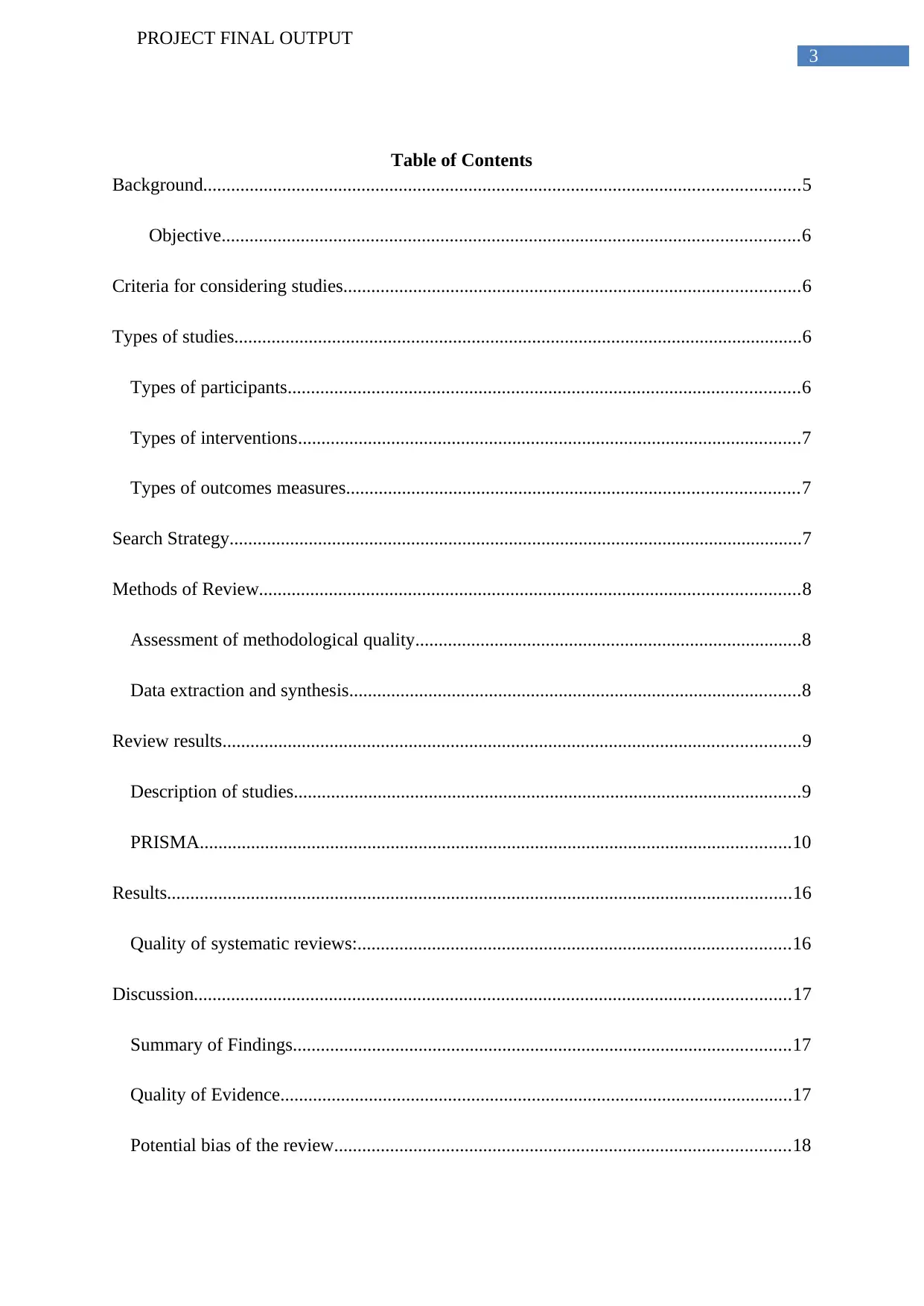
3
PROJECT FINAL OUTPUT
Table of Contents
Background................................................................................................................................5
Objective............................................................................................................................6
Criteria for considering studies..................................................................................................6
Types of studies..........................................................................................................................6
Types of participants..............................................................................................................6
Types of interventions............................................................................................................7
Types of outcomes measures.................................................................................................7
Search Strategy...........................................................................................................................7
Methods of Review....................................................................................................................8
Assessment of methodological quality...................................................................................8
Data extraction and synthesis.................................................................................................8
Review results............................................................................................................................9
Description of studies.............................................................................................................9
PRISMA...............................................................................................................................10
Results......................................................................................................................................16
Quality of systematic reviews:.............................................................................................16
Discussion................................................................................................................................17
Summary of Findings...........................................................................................................17
Quality of Evidence..............................................................................................................17
Potential bias of the review..................................................................................................18
PROJECT FINAL OUTPUT
Table of Contents
Background................................................................................................................................5
Objective............................................................................................................................6
Criteria for considering studies..................................................................................................6
Types of studies..........................................................................................................................6
Types of participants..............................................................................................................6
Types of interventions............................................................................................................7
Types of outcomes measures.................................................................................................7
Search Strategy...........................................................................................................................7
Methods of Review....................................................................................................................8
Assessment of methodological quality...................................................................................8
Data extraction and synthesis.................................................................................................8
Review results............................................................................................................................9
Description of studies.............................................................................................................9
PRISMA...............................................................................................................................10
Results......................................................................................................................................16
Quality of systematic reviews:.............................................................................................16
Discussion................................................................................................................................17
Summary of Findings...........................................................................................................17
Quality of Evidence..............................................................................................................17
Potential bias of the review..................................................................................................18
Paraphrase This Document
Need a fresh take? Get an instant paraphrase of this document with our AI Paraphraser
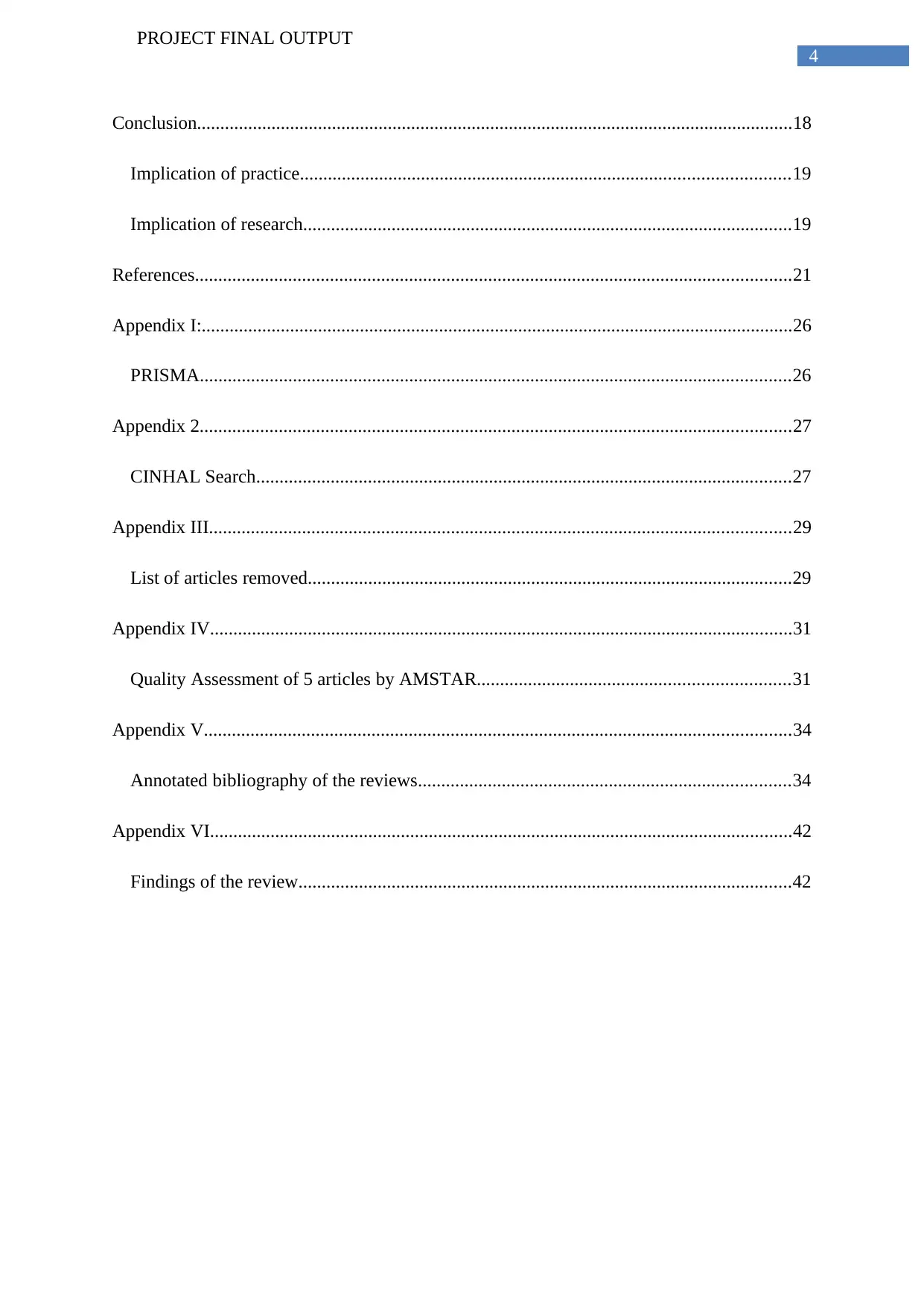
4
PROJECT FINAL OUTPUT
Conclusion................................................................................................................................18
Implication of practice.........................................................................................................19
Implication of research.........................................................................................................19
References................................................................................................................................21
Appendix I:...............................................................................................................................26
PRISMA...............................................................................................................................26
Appendix 2...............................................................................................................................27
CINHAL Search...................................................................................................................27
Appendix III.............................................................................................................................29
List of articles removed........................................................................................................29
Appendix IV.............................................................................................................................31
Quality Assessment of 5 articles by AMSTAR...................................................................31
Appendix V..............................................................................................................................34
Annotated bibliography of the reviews................................................................................34
Appendix VI.............................................................................................................................42
Findings of the review..........................................................................................................42
PROJECT FINAL OUTPUT
Conclusion................................................................................................................................18
Implication of practice.........................................................................................................19
Implication of research.........................................................................................................19
References................................................................................................................................21
Appendix I:...............................................................................................................................26
PRISMA...............................................................................................................................26
Appendix 2...............................................................................................................................27
CINHAL Search...................................................................................................................27
Appendix III.............................................................................................................................29
List of articles removed........................................................................................................29
Appendix IV.............................................................................................................................31
Quality Assessment of 5 articles by AMSTAR...................................................................31
Appendix V..............................................................................................................................34
Annotated bibliography of the reviews................................................................................34
Appendix VI.............................................................................................................................42
Findings of the review..........................................................................................................42
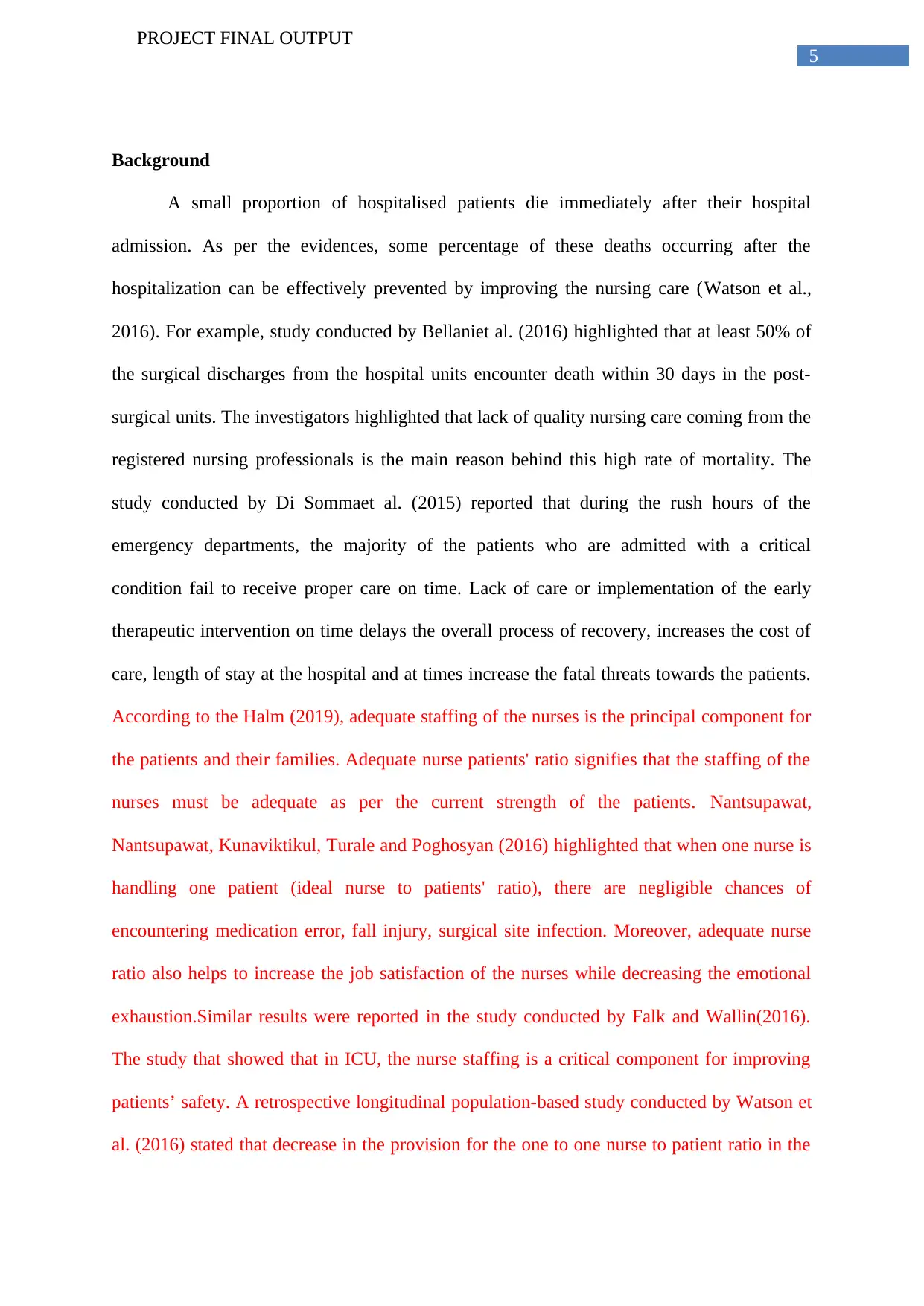
5
PROJECT FINAL OUTPUT
Background
A small proportion of hospitalised patients die immediately after their hospital
admission. As per the evidences, some percentage of these deaths occurring after the
hospitalization can be effectively prevented by improving the nursing care (Watson et al.,
2016). For example, study conducted by Bellaniet al. (2016) highlighted that at least 50% of
the surgical discharges from the hospital units encounter death within 30 days in the post-
surgical units. The investigators highlighted that lack of quality nursing care coming from the
registered nursing professionals is the main reason behind this high rate of mortality. The
study conducted by Di Sommaet al. (2015) reported that during the rush hours of the
emergency departments, the majority of the patients who are admitted with a critical
condition fail to receive proper care on time. Lack of care or implementation of the early
therapeutic intervention on time delays the overall process of recovery, increases the cost of
care, length of stay at the hospital and at times increase the fatal threats towards the patients.
According to the Halm (2019), adequate staffing of the nurses is the principal component for
the patients and their families. Adequate nurse patients' ratio signifies that the staffing of the
nurses must be adequate as per the current strength of the patients. Nantsupawat,
Nantsupawat, Kunaviktikul, Turale and Poghosyan (2016) highlighted that when one nurse is
handling one patient (ideal nurse to patients' ratio), there are negligible chances of
encountering medication error, fall injury, surgical site infection. Moreover, adequate nurse
ratio also helps to increase the job satisfaction of the nurses while decreasing the emotional
exhaustion.Similar results were reported in the study conducted by Falk and Wallin(2016).
The study that showed that in ICU, the nurse staffing is a critical component for improving
patients’ safety. A retrospective longitudinal population-based study conducted by Watson et
al. (2016) stated that decrease in the provision for the one to one nurse to patient ratio in the
PROJECT FINAL OUTPUT
Background
A small proportion of hospitalised patients die immediately after their hospital
admission. As per the evidences, some percentage of these deaths occurring after the
hospitalization can be effectively prevented by improving the nursing care (Watson et al.,
2016). For example, study conducted by Bellaniet al. (2016) highlighted that at least 50% of
the surgical discharges from the hospital units encounter death within 30 days in the post-
surgical units. The investigators highlighted that lack of quality nursing care coming from the
registered nursing professionals is the main reason behind this high rate of mortality. The
study conducted by Di Sommaet al. (2015) reported that during the rush hours of the
emergency departments, the majority of the patients who are admitted with a critical
condition fail to receive proper care on time. Lack of care or implementation of the early
therapeutic intervention on time delays the overall process of recovery, increases the cost of
care, length of stay at the hospital and at times increase the fatal threats towards the patients.
According to the Halm (2019), adequate staffing of the nurses is the principal component for
the patients and their families. Adequate nurse patients' ratio signifies that the staffing of the
nurses must be adequate as per the current strength of the patients. Nantsupawat,
Nantsupawat, Kunaviktikul, Turale and Poghosyan (2016) highlighted that when one nurse is
handling one patient (ideal nurse to patients' ratio), there are negligible chances of
encountering medication error, fall injury, surgical site infection. Moreover, adequate nurse
ratio also helps to increase the job satisfaction of the nurses while decreasing the emotional
exhaustion.Similar results were reported in the study conducted by Falk and Wallin(2016).
The study that showed that in ICU, the nurse staffing is a critical component for improving
patients’ safety. A retrospective longitudinal population-based study conducted by Watson et
al. (2016) stated that decrease in the provision for the one to one nurse to patient ratio in the
⊘ This is a preview!⊘
Do you want full access?
Subscribe today to unlock all pages.

Trusted by 1+ million students worldwide
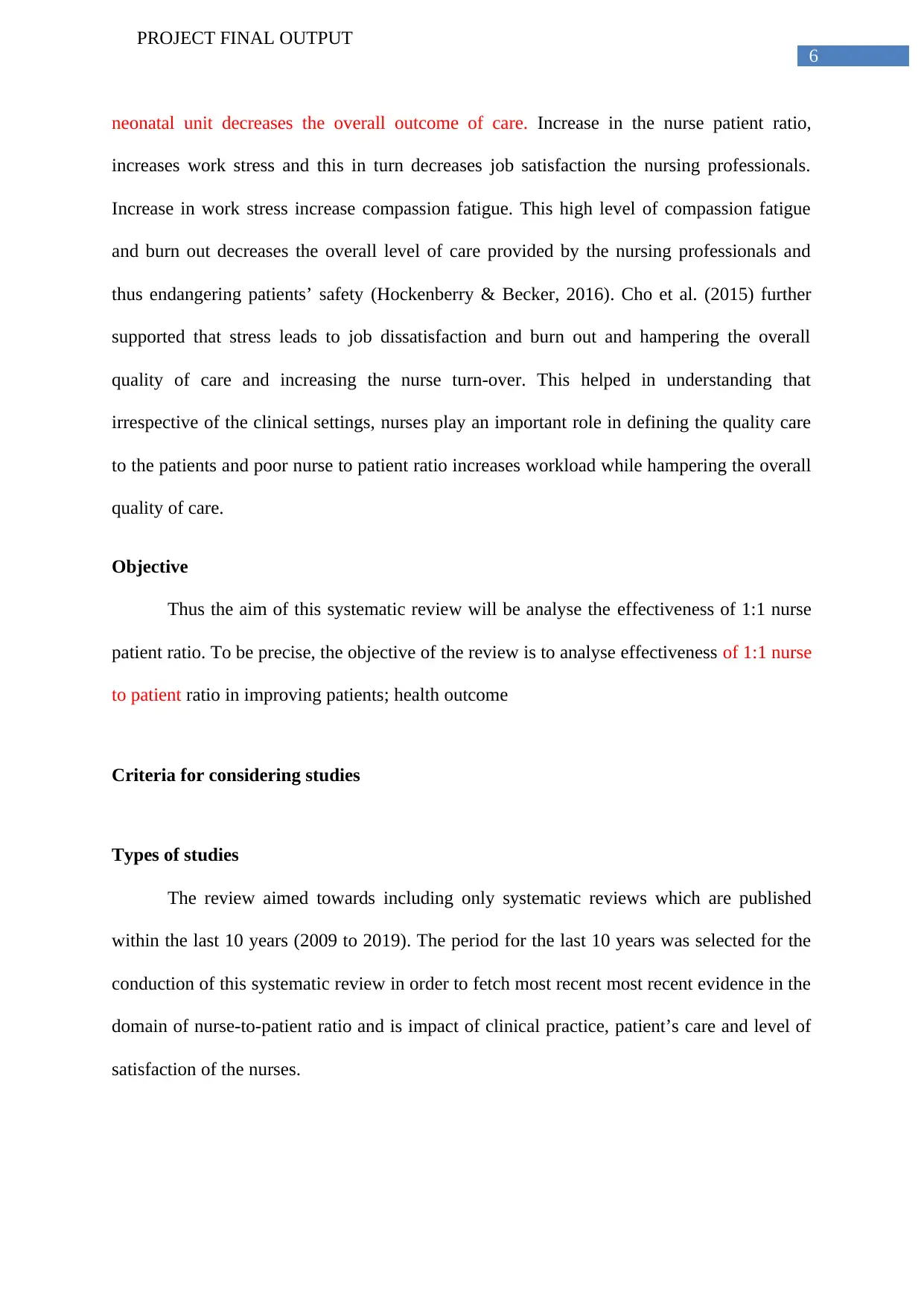
6
PROJECT FINAL OUTPUT
neonatal unit decreases the overall outcome of care. Increase in the nurse patient ratio,
increases work stress and this in turn decreases job satisfaction the nursing professionals.
Increase in work stress increase compassion fatigue. This high level of compassion fatigue
and burn out decreases the overall level of care provided by the nursing professionals and
thus endangering patients’ safety (Hockenberry & Becker, 2016). Cho et al. (2015) further
supported that stress leads to job dissatisfaction and burn out and hampering the overall
quality of care and increasing the nurse turn-over. This helped in understanding that
irrespective of the clinical settings, nurses play an important role in defining the quality care
to the patients and poor nurse to patient ratio increases workload while hampering the overall
quality of care.
Objective
Thus the aim of this systematic review will be analyse the effectiveness of 1:1 nurse
patient ratio. To be precise, the objective of the review is to analyse effectiveness of 1:1 nurse
to patient ratio in improving patients; health outcome
Criteria for considering studies
Types of studies
The review aimed towards including only systematic reviews which are published
within the last 10 years (2009 to 2019). The period for the last 10 years was selected for the
conduction of this systematic review in order to fetch most recent most recent evidence in the
domain of nurse-to-patient ratio and is impact of clinical practice, patient’s care and level of
satisfaction of the nurses.
PROJECT FINAL OUTPUT
neonatal unit decreases the overall outcome of care. Increase in the nurse patient ratio,
increases work stress and this in turn decreases job satisfaction the nursing professionals.
Increase in work stress increase compassion fatigue. This high level of compassion fatigue
and burn out decreases the overall level of care provided by the nursing professionals and
thus endangering patients’ safety (Hockenberry & Becker, 2016). Cho et al. (2015) further
supported that stress leads to job dissatisfaction and burn out and hampering the overall
quality of care and increasing the nurse turn-over. This helped in understanding that
irrespective of the clinical settings, nurses play an important role in defining the quality care
to the patients and poor nurse to patient ratio increases workload while hampering the overall
quality of care.
Objective
Thus the aim of this systematic review will be analyse the effectiveness of 1:1 nurse
patient ratio. To be precise, the objective of the review is to analyse effectiveness of 1:1 nurse
to patient ratio in improving patients; health outcome
Criteria for considering studies
Types of studies
The review aimed towards including only systematic reviews which are published
within the last 10 years (2009 to 2019). The period for the last 10 years was selected for the
conduction of this systematic review in order to fetch most recent most recent evidence in the
domain of nurse-to-patient ratio and is impact of clinical practice, patient’s care and level of
satisfaction of the nurses.
Paraphrase This Document
Need a fresh take? Get an instant paraphrase of this document with our AI Paraphraser
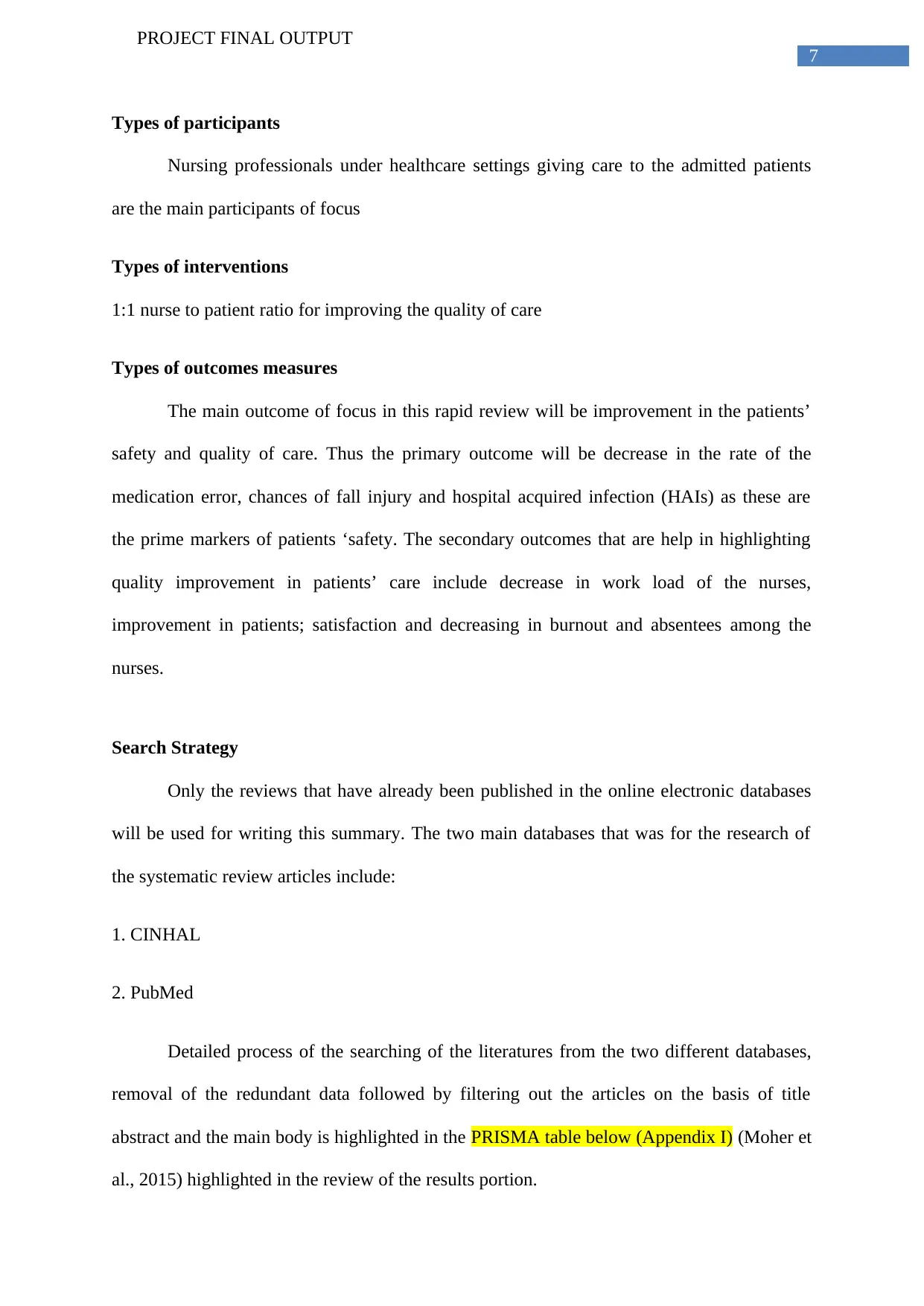
7
PROJECT FINAL OUTPUT
Types of participants
Nursing professionals under healthcare settings giving care to the admitted patients
are the main participants of focus
Types of interventions
1:1 nurse to patient ratio for improving the quality of care
Types of outcomes measures
The main outcome of focus in this rapid review will be improvement in the patients’
safety and quality of care. Thus the primary outcome will be decrease in the rate of the
medication error, chances of fall injury and hospital acquired infection (HAIs) as these are
the prime markers of patients ‘safety. The secondary outcomes that are help in highlighting
quality improvement in patients’ care include decrease in work load of the nurses,
improvement in patients; satisfaction and decreasing in burnout and absentees among the
nurses.
Search Strategy
Only the reviews that have already been published in the online electronic databases
will be used for writing this summary. The two main databases that was for the research of
the systematic review articles include:
1. CINHAL
2. PubMed
Detailed process of the searching of the literatures from the two different databases,
removal of the redundant data followed by filtering out the articles on the basis of title
abstract and the main body is highlighted in the PRISMA table below (Appendix I) (Moher et
al., 2015) highlighted in the review of the results portion.
PROJECT FINAL OUTPUT
Types of participants
Nursing professionals under healthcare settings giving care to the admitted patients
are the main participants of focus
Types of interventions
1:1 nurse to patient ratio for improving the quality of care
Types of outcomes measures
The main outcome of focus in this rapid review will be improvement in the patients’
safety and quality of care. Thus the primary outcome will be decrease in the rate of the
medication error, chances of fall injury and hospital acquired infection (HAIs) as these are
the prime markers of patients ‘safety. The secondary outcomes that are help in highlighting
quality improvement in patients’ care include decrease in work load of the nurses,
improvement in patients; satisfaction and decreasing in burnout and absentees among the
nurses.
Search Strategy
Only the reviews that have already been published in the online electronic databases
will be used for writing this summary. The two main databases that was for the research of
the systematic review articles include:
1. CINHAL
2. PubMed
Detailed process of the searching of the literatures from the two different databases,
removal of the redundant data followed by filtering out the articles on the basis of title
abstract and the main body is highlighted in the PRISMA table below (Appendix I) (Moher et
al., 2015) highlighted in the review of the results portion.
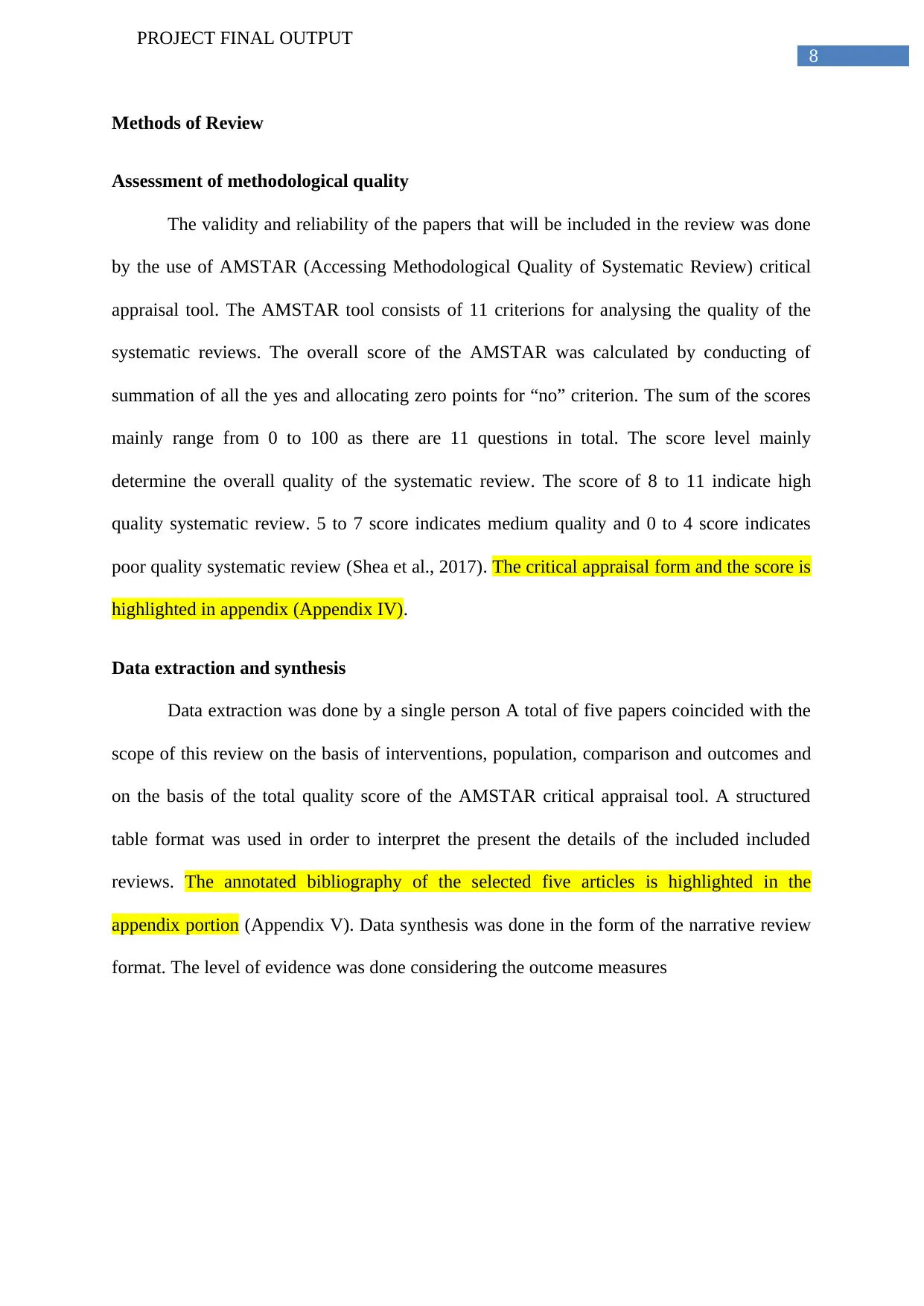
8
PROJECT FINAL OUTPUT
Methods of Review
Assessment of methodological quality
The validity and reliability of the papers that will be included in the review was done
by the use of AMSTAR (Accessing Methodological Quality of Systematic Review) critical
appraisal tool. The AMSTAR tool consists of 11 criterions for analysing the quality of the
systematic reviews. The overall score of the AMSTAR was calculated by conducting of
summation of all the yes and allocating zero points for “no” criterion. The sum of the scores
mainly range from 0 to 100 as there are 11 questions in total. The score level mainly
determine the overall quality of the systematic review. The score of 8 to 11 indicate high
quality systematic review. 5 to 7 score indicates medium quality and 0 to 4 score indicates
poor quality systematic review (Shea et al., 2017). The critical appraisal form and the score is
highlighted in appendix (Appendix IV).
Data extraction and synthesis
Data extraction was done by a single person A total of five papers coincided with the
scope of this review on the basis of interventions, population, comparison and outcomes and
on the basis of the total quality score of the AMSTAR critical appraisal tool. A structured
table format was used in order to interpret the present the details of the included included
reviews. The annotated bibliography of the selected five articles is highlighted in the
appendix portion (Appendix V). Data synthesis was done in the form of the narrative review
format. The level of evidence was done considering the outcome measures
PROJECT FINAL OUTPUT
Methods of Review
Assessment of methodological quality
The validity and reliability of the papers that will be included in the review was done
by the use of AMSTAR (Accessing Methodological Quality of Systematic Review) critical
appraisal tool. The AMSTAR tool consists of 11 criterions for analysing the quality of the
systematic reviews. The overall score of the AMSTAR was calculated by conducting of
summation of all the yes and allocating zero points for “no” criterion. The sum of the scores
mainly range from 0 to 100 as there are 11 questions in total. The score level mainly
determine the overall quality of the systematic review. The score of 8 to 11 indicate high
quality systematic review. 5 to 7 score indicates medium quality and 0 to 4 score indicates
poor quality systematic review (Shea et al., 2017). The critical appraisal form and the score is
highlighted in appendix (Appendix IV).
Data extraction and synthesis
Data extraction was done by a single person A total of five papers coincided with the
scope of this review on the basis of interventions, population, comparison and outcomes and
on the basis of the total quality score of the AMSTAR critical appraisal tool. A structured
table format was used in order to interpret the present the details of the included included
reviews. The annotated bibliography of the selected five articles is highlighted in the
appendix portion (Appendix V). Data synthesis was done in the form of the narrative review
format. The level of evidence was done considering the outcome measures
⊘ This is a preview!⊘
Do you want full access?
Subscribe today to unlock all pages.

Trusted by 1+ million students worldwide
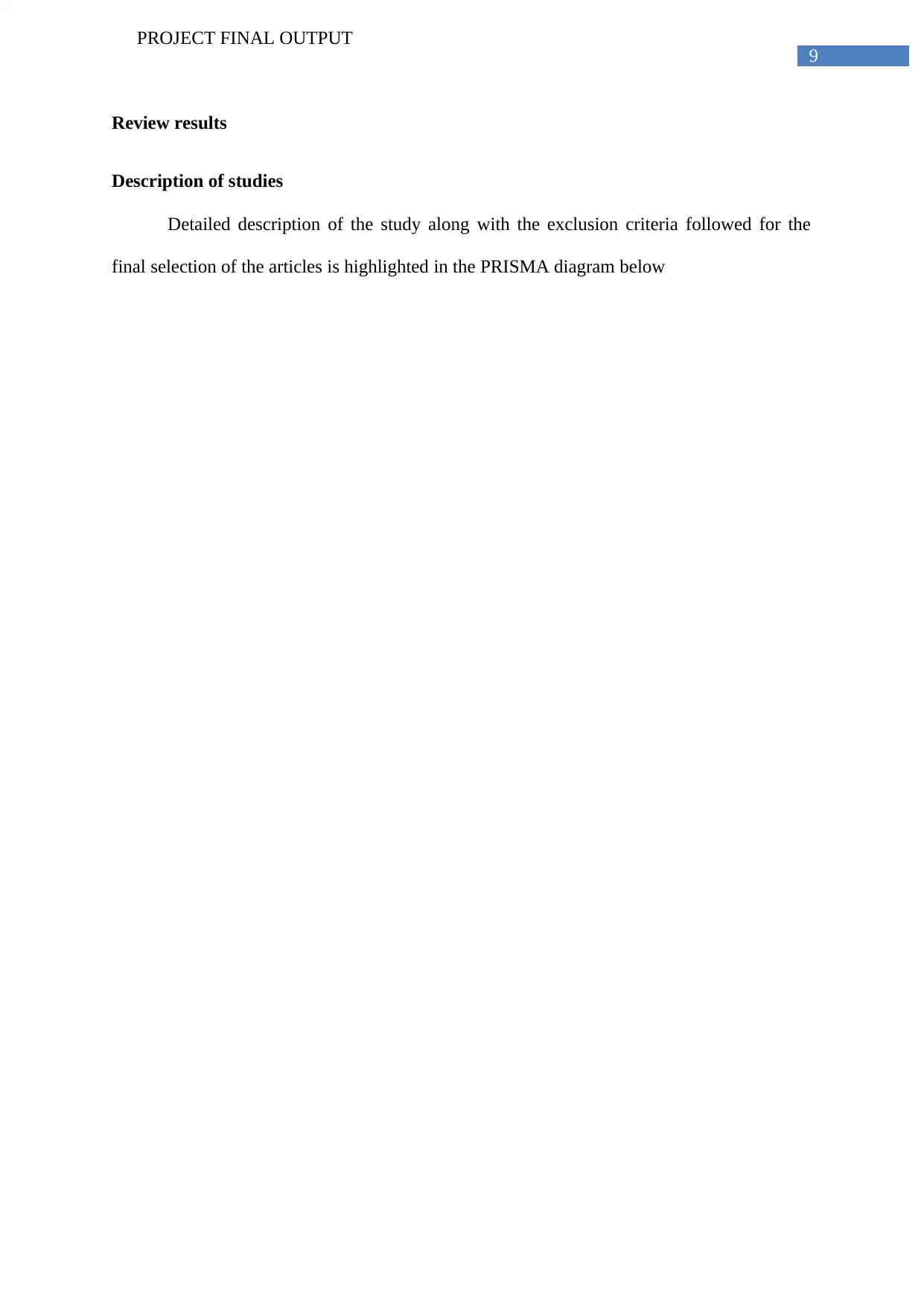
9
PROJECT FINAL OUTPUT
Review results
Description of studies
Detailed description of the study along with the exclusion criteria followed for the
final selection of the articles is highlighted in the PRISMA diagram below
PROJECT FINAL OUTPUT
Review results
Description of studies
Detailed description of the study along with the exclusion criteria followed for the
final selection of the articles is highlighted in the PRISMA diagram below
Paraphrase This Document
Need a fresh take? Get an instant paraphrase of this document with our AI Paraphraser
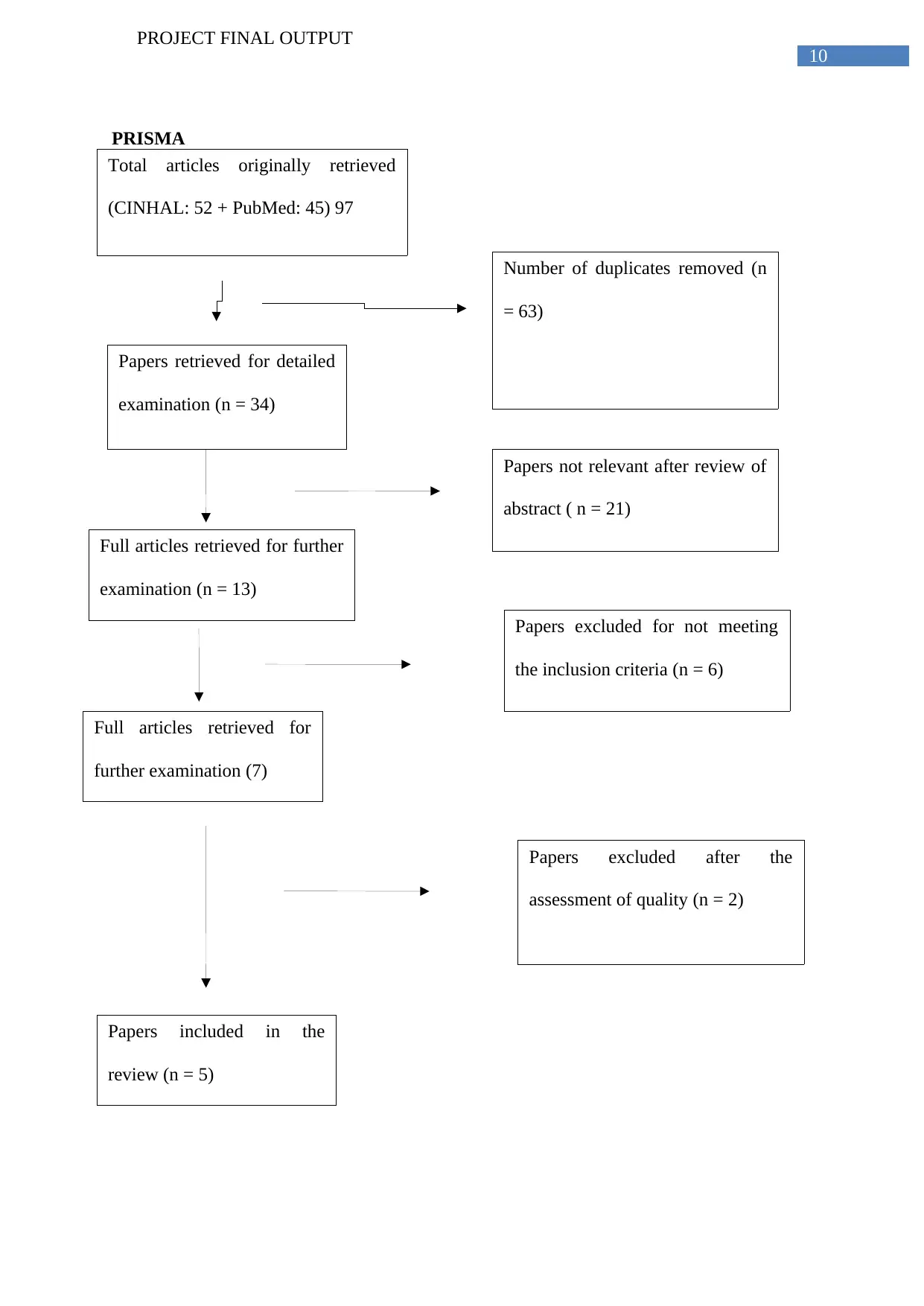
10
PROJECT FINAL OUTPUT
PRISMA
Total articles originally retrieved
(CINHAL: 52 + PubMed: 45) 97
Number of duplicates removed (n
= 63)
Full articles retrieved for further
examination (n = 13)
Papers not relevant after review of
abstract ( n = 21)
Papers retrieved for detailed
examination (n = 34)
Full articles retrieved for
further examination (7)
Papers included in the
review (n = 5)
Papers excluded for not meeting
the inclusion criteria (n = 6)
Papers excluded after the
assessment of quality (n = 2)
PROJECT FINAL OUTPUT
PRISMA
Total articles originally retrieved
(CINHAL: 52 + PubMed: 45) 97
Number of duplicates removed (n
= 63)
Full articles retrieved for further
examination (n = 13)
Papers not relevant after review of
abstract ( n = 21)
Papers retrieved for detailed
examination (n = 34)
Full articles retrieved for
further examination (7)
Papers included in the
review (n = 5)
Papers excluded for not meeting
the inclusion criteria (n = 6)
Papers excluded after the
assessment of quality (n = 2)
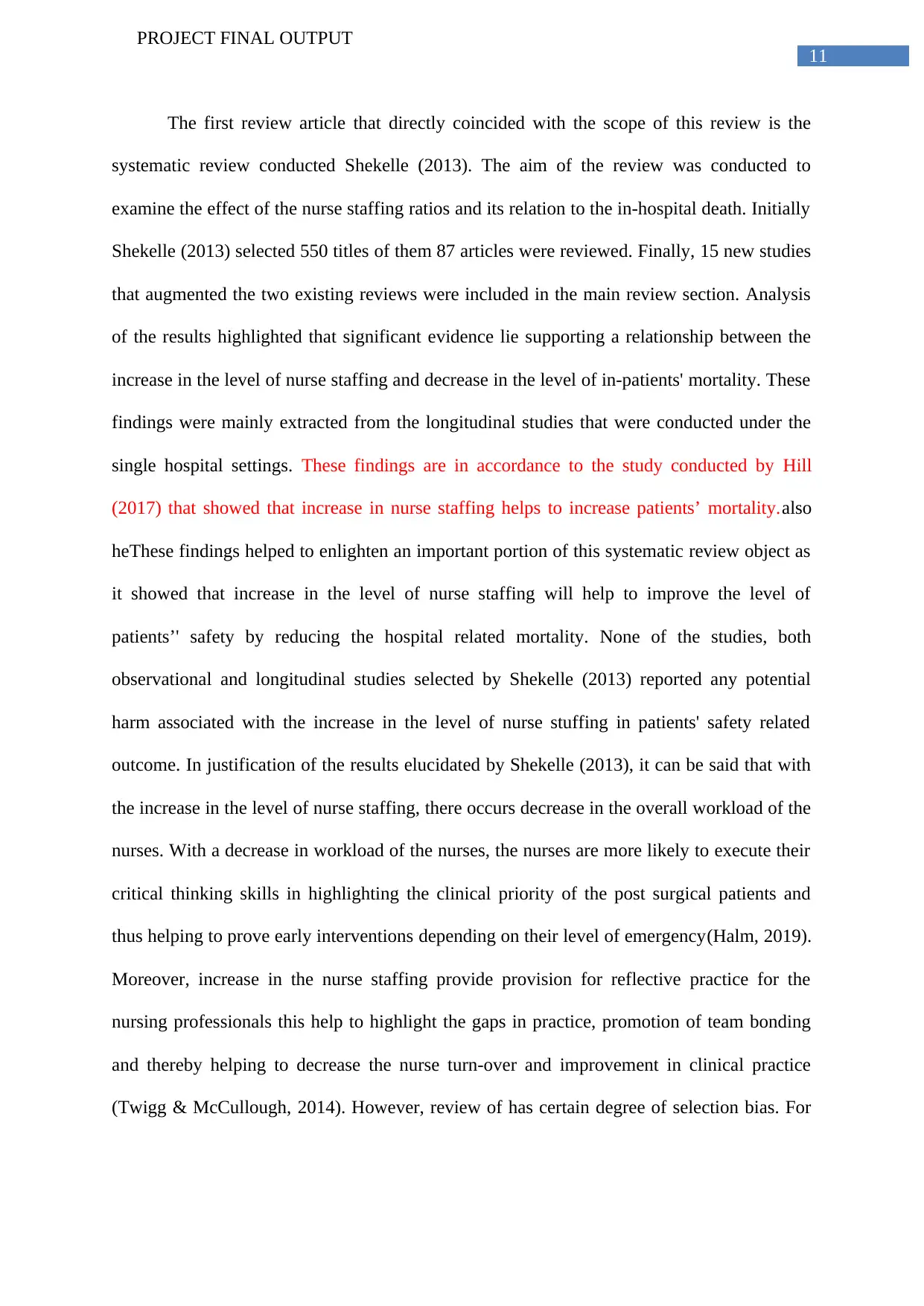
11
PROJECT FINAL OUTPUT
The first review article that directly coincided with the scope of this review is the
systematic review conducted Shekelle (2013). The aim of the review was conducted to
examine the effect of the nurse staffing ratios and its relation to the in-hospital death. Initially
Shekelle (2013) selected 550 titles of them 87 articles were reviewed. Finally, 15 new studies
that augmented the two existing reviews were included in the main review section. Analysis
of the results highlighted that significant evidence lie supporting a relationship between the
increase in the level of nurse staffing and decrease in the level of in-patients' mortality. These
findings were mainly extracted from the longitudinal studies that were conducted under the
single hospital settings. These findings are in accordance to the study conducted by Hill
(2017) that showed that increase in nurse staffing helps to increase patients’ mortality.also
heThese findings helped to enlighten an important portion of this systematic review object as
it showed that increase in the level of nurse staffing will help to improve the level of
patients’' safety by reducing the hospital related mortality. None of the studies, both
observational and longitudinal studies selected by Shekelle (2013) reported any potential
harm associated with the increase in the level of nurse stuffing in patients' safety related
outcome. In justification of the results elucidated by Shekelle (2013), it can be said that with
the increase in the level of nurse staffing, there occurs decrease in the overall workload of the
nurses. With a decrease in workload of the nurses, the nurses are more likely to execute their
critical thinking skills in highlighting the clinical priority of the post surgical patients and
thus helping to prove early interventions depending on their level of emergency(Halm, 2019).
Moreover, increase in the nurse staffing provide provision for reflective practice for the
nursing professionals this help to highlight the gaps in practice, promotion of team bonding
and thereby helping to decrease the nurse turn-over and improvement in clinical practice
(Twigg & McCullough, 2014). However, review of has certain degree of selection bias. For
PROJECT FINAL OUTPUT
The first review article that directly coincided with the scope of this review is the
systematic review conducted Shekelle (2013). The aim of the review was conducted to
examine the effect of the nurse staffing ratios and its relation to the in-hospital death. Initially
Shekelle (2013) selected 550 titles of them 87 articles were reviewed. Finally, 15 new studies
that augmented the two existing reviews were included in the main review section. Analysis
of the results highlighted that significant evidence lie supporting a relationship between the
increase in the level of nurse staffing and decrease in the level of in-patients' mortality. These
findings were mainly extracted from the longitudinal studies that were conducted under the
single hospital settings. These findings are in accordance to the study conducted by Hill
(2017) that showed that increase in nurse staffing helps to increase patients’ mortality.also
heThese findings helped to enlighten an important portion of this systematic review object as
it showed that increase in the level of nurse staffing will help to improve the level of
patients’' safety by reducing the hospital related mortality. None of the studies, both
observational and longitudinal studies selected by Shekelle (2013) reported any potential
harm associated with the increase in the level of nurse stuffing in patients' safety related
outcome. In justification of the results elucidated by Shekelle (2013), it can be said that with
the increase in the level of nurse staffing, there occurs decrease in the overall workload of the
nurses. With a decrease in workload of the nurses, the nurses are more likely to execute their
critical thinking skills in highlighting the clinical priority of the post surgical patients and
thus helping to prove early interventions depending on their level of emergency(Halm, 2019).
Moreover, increase in the nurse staffing provide provision for reflective practice for the
nursing professionals this help to highlight the gaps in practice, promotion of team bonding
and thereby helping to decrease the nurse turn-over and improvement in clinical practice
(Twigg & McCullough, 2014). However, review of has certain degree of selection bias. For
⊘ This is a preview!⊘
Do you want full access?
Subscribe today to unlock all pages.

Trusted by 1+ million students worldwide
1 out of 46
Related Documents
Your All-in-One AI-Powered Toolkit for Academic Success.
+13062052269
info@desklib.com
Available 24*7 on WhatsApp / Email
![[object Object]](/_next/static/media/star-bottom.7253800d.svg)
Unlock your academic potential
Copyright © 2020–2025 A2Z Services. All Rights Reserved. Developed and managed by ZUCOL.





